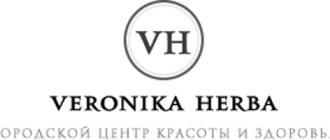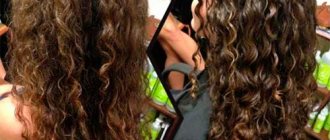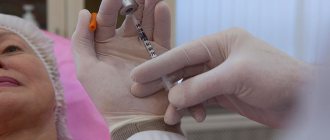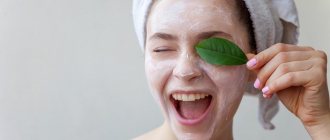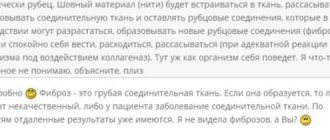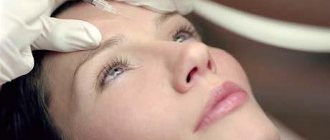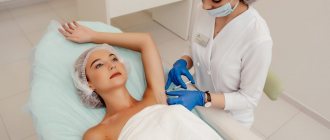What you need to know about Botox
The drug contains inactivated botulinum toxin, type A, which acts as the main active ingredient. The toxin blocks the passage of a nerve impulse, resulting in temporary muscle paralysis and subsequent smoothing of skin folds.
Botox injections are recommended for eliminating expression lines only - the drug is not used to fill tissues and increase their volume.
Indications for use:
- wrinkles of the upper third of the face – horizontal on the forehead, vertical between the eyebrows, “crow’s feet”;
- low or raised eyebrows;
- facial asymmetry and other neurological defects;
- pronounced nasolabial folds;
- wrinkles on the neck (vertical and horizontal).
Two to three days after the injections, the first results appear - this is how long it takes for the toxin to begin to have an effect on the muscles. To obtain a stable result, the procedure should be performed regularly. A repeat course is required at the first signs of muscle recovery. In this case, a certain pattern is observed - with each subsequent administration of the drug, the time of its action increases.
For very deep wrinkles, cosmetologists use Botox in combination with hyaluronic acid preparations, since it is the simultaneous use of products with a fundamentally different mechanism of action that gives the best possible result. Hyaluronic acid fills the tissue and promotes the formation of its own collagen, while botulinum toxin “stretches” the fold by relaxing the muscle.
Botox procedure for face
Botox injections are carried out precisely along markings on the skin. At a preliminary consultation, a cosmetologist assesses the condition of the skin, selects a drug and an approximate dosage, which allows you to maintain natural facial expressions.
Depending on the area of the treated area, the procedure lasts up to half an hour. The patient is in a semi-lying position during the session, which ensures uniform distribution of the drug.
The frequency of the procedure varies up to once every 4-6 months; regularity of the procedures will provide a longer lasting effect of up to 8-10 months.
A transverse wrinkle on the forehead, a wrinkle of anger, small laugh lines near the eyes, asymmetry of the eyebrows - once upon a time these problems could only be solved by plastic surgery. Now Botox injections are coming to help in the fight against wrinkles. Let's figure out what this drug is and how it works.
Botox is a drug popular in cosmetology for smoothing out wrinkles, the scientific name is botulinum neurotoxin type A. It is a purified and weakened poison produced by bacteria.
Microorganisms were discovered by scientists at the end of the 19th century. In the middle of the last century they found an unexpected use. Neurotoxin was used to treat nervous tics, blepharospasm (spasm of the orbicularis oculi muscle), strabismus, achalasia of the esophagus (neuromuscular disorder), muscle pain (convulsions and spasms), and cerebral palsy.
Gradually, the use of Botox expanded. It gave effective results in smoothing wrinkles on the forehead, between the eyebrows, near the eyes and lips. The procedure quickly became popular because it is not as expensive and traumatic as plastic surgery, and the results are similar.
In cosmetology, preparations based on botulinum toxin are used. One of the most popular is the drug Dysport, which is produced in the UK and France. The product contains a small concentration of botulinum toxin. Thanks to this, the drug is safe and does not harm neighboring tissues.
How does the procedure work?
The main goal of Botox injections is to make a person stop using their facial muscles frequently. The drug limits signals between the nerves and muscles of the face, which relaxes the muscles. As a result, wrinkles are smoothed out and new wrinkles will not appear.
During the procedure, the cosmetologist makes injections in the areas to be corrected. Each area requires a different amount of Botox. For example, to smooth the forehead, you need about twice as much drug as for wrinkles near the eyes. For lip correction – half as much as for eyes.
The injection is performed with a short, thin needle into the muscles whose activity needs to be reduced or minimized.
The procedure lasts approximately ten minutes. The result depends on the accuracy of the doctor’s movements and the amount of the drug. If Botox is injected in excess or in the wrong place, muscle tissue may sag. For several months you will have to endure a look that is completely different from what you wanted to get when you consulted a cosmetologist.
Botox injections are a serious procedure, so to avoid the risk of complications and incorrect correction, choose a specialist carefully. It is safer to contact professional beauty salons or clinics.
What happens after the procedure
Smoothing of wrinkles can be noticed on the second to seventh day after the injections. Botox acts on the muscle for 3 months, but wrinkles are formed individually for everyone, depending on the characteristics of facial expressions, so the visible effect lasts from 3 to 6 months, in some cases longer.
The rate at which Botox is removed depends on the characteristics of the body and is impossible to predict during the first procedure.
Immediately after the procedure, you should not sleep for three to four hours or touch the injection sites with your hands. During the day, you should not take medications that affect blood clotting.
For several days you will have to refrain from exposure to the sun, from going to the sauna, bathhouse, solarium, from physical activity, and from drinking alcoholic beverages.
Expert opinion
Botox: how often can you inject the drug?
It takes 3-4 days for the drug to start working, reaching peak results after 2 weeks. After about 2 months, the activity of the facial muscles gradually returns, after 3 months it restores 50% of activity, after 4-6 months – 80%. The reduction in the effect of Botox is due to the gradual removal of botulinum toxin from the body and the restoration of nerve impulses to the muscles.
If the procedure is unsuccessful and the doctor’s recommendations are not followed, Botox will need to be injected every 4 months, which involves significant costs. Therefore, it is necessary to choose a proven cosmetology center, which will ensure a long-lasting effect and the frequency of correction will be once every 6-10 months.
How do Botox injections work?
With age, wrinkles appear on the face, which is associated with a decrease in the production of elastin and collagen, as well as tension in the facial muscles. Botox helps reduce the number of wrinkles, preventing the appearance of new ones; there have been cases when injections were carried out up to 30 years for preventive purposes.
After injecting the drug into the muscle that forms wrinkles, the release of acetylcholine, which promotes the transmission of nerve impulses to the muscle, is blocked. Botox, by disrupting this process, causes temporary paralysis of muscle fibers and their relaxation, allowing even the deepest wrinkles to be smoothed out.
It is worth considering that a decrease in muscle activity is a temporary phenomenon and correction will soon be needed; how often it is necessary to inject Botox around the eyes depends on the age and condition of the skin; after the first session, correction is usually required after 4 months; with regular use, the validity period of botulinum toxin is extended to 8 -10 months.
So, is Botox addictive?
Now that you know what Botox is, I will answer the main question. Botox addiction is a myth. There is no clinical evidence that the injections are addictive. The only circumstance that can explain the occurrence of such a rumor is the fact that women want to remain young and beautiful.
The effect of the injections wears off after six months. Perhaps the changing reflection in the mirror forces women to turn to a cosmetologist again. The drug itself is not a narcotic drug, so it cannot cause addiction.
Indications and contraindications
The procedure using botulinum toxin is indicated for the presence of facial wrinkles near the eyes, on the forehead and the area between the eyebrows, with signs of sagging skin and age-related changes. It is worth noting that Botox injections are only effective for the upper part of the face.
Like any other drug, Botox has a number of contraindications:
- intolerance to drug substances;
- skin diseases and inflammation at the procedure site;
- infections occurring in chronic and acute forms;
- exacerbation of chronic diseases;
- muscle weakness at the injection site;
- period of breastfeeding and pregnancy.
Carrying out the procedure in the presence of contraindications increases the risk of complications and also reduces the effect of the drug. In this case, the effect of Botox wears off after 3-4 months, which requires repeated correction.
What not to do after Botox
The procedure has a minimum rehabilitation period, during which the following actions are prohibited:
- muscle tension in the injection area;
- face massage;
- thermal effects on the face;
- visiting a bathhouse, sauna, solarium;
- taking antibiotics and drugs that interfere with blood clotting;
- use of cosmetics and decorative products;
- facial peeling.
Compliance with these rules reduces the risk of complications and prolongs the duration of action of Botox, which allows the procedure to be carried out no more than once every 6-8 months.
Immunity to injections
Another question is the body’s adaptation to injections. It is known that the human body gets used to everything. Frequent injections over several years can trigger the production of natural antibodies that neutralize the effects of botulinum toxin. This possibility really exists. However, German scientists have found that complete immunity to the drug occurs in women and men who abuse injections for 10–15 years. Some people have an innate immunity to botulinum neurotoxin type A. In this case, the injections will not work to begin with. Such people make up about 3% of the total number.
In most cases, with long-term use of Botox, there is a reduction in the time of its action. After 8–9 courses, the duration of the effect may be reduced by 3 weeks or a month. There is no evidence of a further reduction in the effect.
Botox injections for rejuvenation are today the most proven treatment that does not require surgical intervention. I can guarantee my patients the safety of the procedure and the use of only high-quality drugs.
Botox injection procedure
To select the type and dosage of the drug, a preliminary consultation is carried out. After which the cosmetologist sets the time for the procedure, which consists of the following steps:
- The skin is cleansed with a special product to remove cosmetics, dust and sebum.
- The cosmetologist must outline the points for future injections, for this it is necessary to use the muscles, the doctor asks you to smile, frown, etc.
- Although Botox is administered using a thin needle, providing minimal skin trauma and pain, topical anesthetics are still very often used.
- After the drug begins to act, the doctor injects the required areas.
- Upon completion of the procedure, the skin area is treated with an antiseptic and ice is applied on top to reduce the risk of bruising and swelling.
The whole procedure takes 15-20 minutes, the doctor gives recommendations and advice to help avoid complications, as well as prolong the effect of the drug. How often it is possible and necessary to inject Botox around the eyes also depends on the doctor’s experience and correctness of the procedure. If the injections are carried out by a qualified specialist, and the patient followed all the recommendations, the next correction will be needed only after 6-9 months, otherwise the effectiveness begins to decrease after 4 months.

